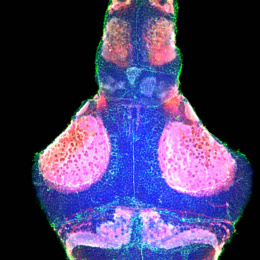Protein Function in Male Reproduction 1
Protein Function in Male Reproduction 1
Submitted by Eric Bell of the Glenn Laboratory for the Science of Aging at MIT
MIT Department of Biology, Koch Institute at MIT
"You are looking at a cross sections of the seminiferous tubules from the testis of a mouse. The testis is the organ in which germ cells from the male are transformed into sperm. The black area in the center of the structure is the lumen; it is where the mature sperm are released. The blue signal marks DNA, which is highly compacted in mature sperm. Moving from the lumen towards the edges of the image you can identify different types of cells, at different stages of transformation, by the blue color. Less differentiated cells are closer to the edge of the circle while the cells closest to the edge of the circle are the stem cells of the testis. The red signal is where the protein, HDAC1, is located. We are studying the role of a protein called SirT1 in male reproduction. When we inhibit SirT1 protein in the testis of mice, we decrease their fertility. SirT1 and HDAC1 proteins perform similar functions in cells and we wanted to know if HDAC1 protein is present in the same cell types in which SirT1 is present."






